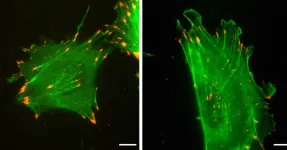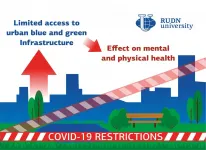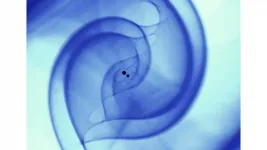Tool helps predicts who will respond best to targeted prostate cancer therapy
New 'nomogram' opens the door to improved personalized treatments, UCLA-led study shows
2021-07-08
(Press-News.org) LOS ANGELES - A new prognostic tool developed by researchers from the UCLA Jonsson Comprehensive Cancer Center and five other institutions helps predict which men with advanced metastatic prostate cancer will respond favorably to a novel targeted therapy.
The tool, described in a study published today in Lancet Oncology, analyzes a wide spectrum of imaging and clinical data and is intended to assist physicians considering treating patients with Lutetium-177 prostate-specific membrane antigen, or LuPSMA.
LuPSMA, which binds to PSMA proteins and delivers targeted radiation to prostate cancer tissue, offers a new option to men with PSMA-positive metastatic cancer that is castration-resistant, meaning it has stopped responding to hormone therapy. LuPSMA is currently pending approval by the U.S. Food and Drug Administration.
Candidates for the therapy are typically screened using a technique pioneered by UCLA and UC San Francisco called PSMA PET imaging, which combines positron emission tomography with a PET-sensitive drug to detect prostate cancer throughout the body and verify PSMA-expression in the tumors.
The new research demonstrates that a combination of clinical characteristics and PSMA PET imaging characteristics and can be used to predict which patients will have improved progression-free survival (slower disease progression) and improved overall survival (life expectancy) as a result of the treatment.
"Until now, there has been no validated tool to adequately predict the response of patients with advanced metastatic prostate cancer to LuPSMA treatment," said lead author Dr. Andrei Gafita, a postdoctoral scholar in the Ahmanson Translational Theranostics Division of the department of molecular and medical pharmacology at the David Geffen School of Medicine at UCLA. "Most important, this study suggests that screening with PSMA PET imaging could help to select patients who are most likely to benefit from this treatment."
Creating the 'nomogram'
The predictive tool -- commonly called a nomogram -- was developed by researchers from institutions across Europe, Australia and the U.S. who analyzed data from 270 prostate cancer patients who underwent LuPSMA treatment in clinical trials or via compassionate use.
The research team used eight parameters -- including PSMA PET parameters and factors such as the time since initial diagnosis, chemotherapy status and hemoglobin levels -- to create the mathematical formula that allows the tool to predict survival.
Based on the nomogram, the researchers also created a web-based risk calculator that forecasts the probability of overall and progression-free survival in response to LuPSMA. The predictions are used to stratify men into either high-risk or low-risk groups.
In the men studied, those identified by the tool as low risk had longer overall survival (24 months) and progression-free survival (6 months) than those classified as high risk (6 months and 2 months, respectively).
The findings from the research are encouraging, Gafita said, and may provide the foundation for patient selection for LuPSMA therapy. Nevertheless, he notes, until its clinical validity is demonstrated in prospective trials, the tool should be used cautiously and should not replace the clinical judgement of treating physicians.
"Our validated tool can find application particularly at institutions where LuPSMA is just being introduced as a novel therapeutic option," he said.
INFORMATION:
The work was supported by the Prostate Cancer Foundation. Gafita was supported by a fellowship grant from the Jonsson Cancer Center and a Dr. Christiaan Schiepers Postdoctoral Fellowship Award.
Other UCLA authors include Dr. Jeremie Calais, Dr. Johannes Czernin, Wesley Armstrong and Pan Thin of the Ahmanson Translational Theranostics Division; Tristan Grogan and David Elashoff of the department of medicine statistics core; and Dr. Matthew Rettig of the department of urology.
Authors from other participating institutions include Drs. Matthias Eiber (senior author) and Robert Tauber of the Technical University of Munich in Germany; Drs. Michael Hofman and Shahneen Sandhu of the Peter MacCallum Cancer Center in Australia; Drs. Wolfgang Fendler, Ken Herrmann and Boris Hadaschik from Essen University Hospital in Germany; Drs. Clemens Kratochwil and Uwe Haberkorn of Heidelberg University Hospital in Germany; and Drs. Ebrahim Delpassand and Rouzbeh Esfandiari of Excel Diagnostics in Houston, Texas.
ELSE PRESS RELEASES FROM THIS DATE:
2021-07-07
The protein actin is ubiquitous and essential for life. In mammals, every cell expresses two of its forms, beta-actin and gamma-nonmuscle-actin. Despite having distinct roles, the two forms are nearly identical, sharing 99% of their amino acid sequence.
Research by Anna Kashina of Penn's School of Veterinary Medicine and colleagues has shown that, contrary to scientific dogma, it's not the slight differences in amino acid sequence that govern these proteins' discrete functions in the cell. Rather, their nucleotide sequences--the "letters" that make up their DNA coding sequence, which differ by roughly 13% between the two forms--are responsible for their individual roles in organisms' ...
2021-07-07
Researchers have produced vaccine-like immune responses to a dangerous bacterium by colonizing 26 healthy volunteers with a related, but harmless, commensal bacterial species. The first-in-human, controlled infection study showed the strategy was safe, as no side effects were reported and the volunteers didn't transmit the commensal bacteria to bedroom-sharers over the 90-day study. Neisseria lactamica is a member of the microbiome that usually resides in the upper airways of children but can also safely colonize the airways of adults. Some researchers theorize that these bacteria ...
2021-07-07
By 2050, faster adoption of electric vehicles (EVs) and faster generation of renewable energy will result in 99% less fossil fuel consumed and 93% less CO2 emissions from passenger and freight vehicles on O?ahu. That's under the most ambitious scenario in an article published in World Electric Vehicle Journal, by University of Hawai?i at Mānoa School of Ocean and Earth Science and Technology (SOEST) faculty member Katherine McKenzie.
McKenzie, based at the Hawai?i Natural Energy Institute in SOEST, created mathematical models of four scenarios based on projections for the switch to electric passenger and freight ...
2021-07-07
Five years ago, researchers at Northwestern University made international headlines when they discovered that human eggs, when fertilized by sperm, release billions of zinc ions, dubbed "zinc sparks."
Now, Northwestern has teamed up with the U.S. Department of Energy's (DOE) Argonne National Laboratory and Michigan State University (MSU) to reveal that these same sparks fly from highly specialized metal-loaded compartments at the egg surface when frog eggs are fertilized. This means that the early chemistry of conception has evolutionary roots going back at least 300 million years, to the last common ancestor between frogs and people.
"This work may help inform our understanding of the interplay of dietary zinc status and human fertility." -- Thomas O'Halloran, professor, Michigan State ...
2021-07-07
The measures taken during the COVID-19 pandemic limited the access of citizens to natural objects. It is still unexplored, what consequences this had for the residents and what conclusions should be drawn for more effective urban planning. RUDN University scientists with colleagues from Australia and Germany studied how the restrictions associated with COVID-19 affected the use of blue and green infrastructure by citizens in Moscow (Russia) and Perth (Australia), and what consequences this had for their health. In the article "Human Dimensions of Urban Blue and Green Infrastructure during a Pandemic. The Case Study of Moscow (Russia) ...
2021-07-07
Bahamian mosquitofish in habitats fragmented by human activity are more willing to explore their environment, more stressed by change and have smaller brain regions associated with fear response than mosquitofish from unaffected habitats. The new study from North Carolina State University shows that these fish have adapted quickly in specific ways to human-driven change, and cautions that environmental restoration projects should understand these changes so as not to damage adapted populations.
The Bahamas mosquitofish is a small, coastal fish species that frequently inhabits tidal creeks - shallow, tidally influenced marine ecosystems. ...
2021-07-07
In 2019, Anaïs Llorens and Athina Tzovara -- one a current, the other a former University of California, Berkeley, postdoctoral scholar at the Helen Wills Neuroscience Institute (HWNI) -- were attending a scientific meeting and pleased that one session, on gender bias in academia, attracted nearly a full house. The problem: The audience of some 300 was almost all women.
Where were the men, they wondered? More than 75% of all tenured faculty in Ph.D. programs around the world are men, making their participation key to solving the problem of gender bias, which negatively impacts the careers, work-life balance and mental health of all women in science, and even more ...
2021-07-07
FOR IMMEDIATE RELEASE
In what turned out to be one of the most important accidents of all time, Scottish bacteriologist Alexander Fleming returned to his laboratory after a vacation in 1928 to find a clear zone surrounding a piece of mold that had infiltrated a petri dish full of Staphylococcus aureus (S. aureus), a common skin bacterium he was growing.
That region of no bacterial growth was the unplanned birth of a medical miracle, penicillin, and would lead to the era of antibiotics. Now, END ...
2021-07-07
When gravitational waves were first detected in 2015 by the advanced Laser Interferometer Gravitational-Wave Observatory (LIGO), they sent a ripple through the scientific community, as they confirmed another of Einstein's theories and marked the birth of gravitational wave astronomy. Five years later, numerous gravitational wave sources have been detected, including the first observation of two colliding neutron stars in gravitational and electromagnetic waves.
As LIGO and its international partners continue to upgrade their detectors' sensitivity to gravitational waves, they will be able to probe a larger volume of the universe, thereby making the detection ...
2021-07-07
As the COVID-19 pandemic wanes in the U.S., a new study from the University of Maryland School of Medicine (UMSOM) and University of Maryland Medical Center (UMMC) finds that hospitals nationwide may not be adequately prepared for the next pandemic. A 10-year analysis of hospitals' preparedness for pandemics and other mass casualty events found only marginal improvements in a measurement to assess preparedness during the years leading up to the COVID-19 pandemic. The study was published last month in the Journal of Healthcare Management.
"Our work links objective healthcare data to a hospital score that ...
LAST 30 PRESS RELEASES:
[Press-News.org] Tool helps predicts who will respond best to targeted prostate cancer therapy
New 'nomogram' opens the door to improved personalized treatments, UCLA-led study shows





